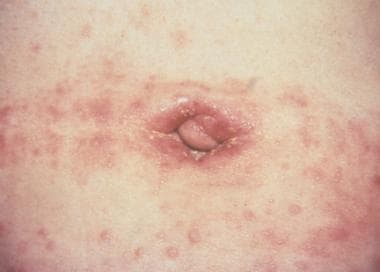Background
The Candida fungus is both normal flora and an invasive pathogen. The range of infection with Candida species varies from a benign local mucosal membrane infection to disseminated disease. Severe disease is typically associated with an immunocompromised state, which includes patients who are vulnerable to iatrogenic pathogens in the intensive care unit (ICU) or those with predisposing immunologic conditions such as malignancy, organ dysfunction, or immunosuppressive therapy.
Rash due to candidiasis is shown in the images below.
 Candidiasis. Erythema, maceration, and satellite pustules in the axilla, accompanied by soreness and pruritus, result in a form of intertrigo. Image courtesy of Matthew C Lambiase, DO.
Candidiasis. Erythema, maceration, and satellite pustules in the axilla, accompanied by soreness and pruritus, result in a form of intertrigo. Image courtesy of Matthew C Lambiase, DO.
Pathophysiology
Candida is a unicellular yeast whose cells reproduce by budding. This organism can flourish in most environments. It frequently colonizes the oropharynx, skin, mucous membranes, lower respiratory tract, gastrointestinal tract, and genitourinary tract. Pathogenesis occurs with increased fungal burden and colonization, such as in the setting of broad-spectrum antimicrobial therapy; breakdown of normal mucosal and skin barriers, which can occur with indwelling intravascular devices or with recent surgery/trauma or tissue damage secondary to chemotherapy or radiation; or immune dysfunction secondary to disease states or iatrogenic conditions.
Candidiasis is the most common opportunistic fungal infection. Disease manifestations of candidal infection can vary by type of host immunodeficiency. Lymphocytes and cell-mediated immunity are important in the prevention of mucosal candidiasis. Therefore, patients with T-cell deficiency, such as those with human immunodeficiency virus (HIV), have a propensity to develop recurrent and/or persistent mucocutaneous candidiasis. Patients with neutropenia are at risk for invasive candidiasis and candidemia, as functioning monocytes and polymorphonuclear cells are responsible for killing pseudohyphae and blastospores. Complement and immunoglobulins are necessary for intracellular killing of the organisms, and patients with these deficiencies can have a more prolonged and complicated course of candidal infection.
Epidemiology
Frequency
United States
Candida is the third or fourth most common cause of nosocomial bloodstream infection in the United States, accounting for 8%-10% of all bloodstream infections. [1]
Invasive candidiasis is the most common invasive fungal infection in the United States, accounting for 70%-90% of all invasive fungal infections. [1] There is an increasing shift toward infections caused by non-albicans Candida species, which now cause 40%-60% of reported cases.
International
In Europe, Candida species are the sixth to tenth most common cause of bloodstream infections. [1]
Candida species distribution varies from country to country in Europe; however, Candida glabrata and Candida parapsilosis tend to be the most common isolates after Candida albicans in invasive candidiasis. [2]
Invasive candidiasis is still most commonly due to C albicans in Latin American countries; however, unlike in North America, C parapsilosis is the second most common Candida species in many Latin American countries. Furthermore, Candida tropicalis infection has also increased in frequency. [3]
In one study, non-albicans Candida accounted for 70% of candidemia cases in a northern Indian pediatric ICU. Isolated Candida species included C tropicalis (48.4%), C albicans (29.7%), Candida guilliermondii (14.1%), C krusei (6.3%), and C glabrata (1.6%).
C glabrata and C krusei have been identified as common causes of candidemia in patients with hematologic malignancies. [4]
C parapsilosis has been identified as the leading cause of candidemia secondary to medical instrumentation such as with central venous catheters, prosthetic devices, and nosocomial spread. [5]
C dubliniensis has been identified in an immunocompromised patient with multifocal osteomyelitis in Germany [6] and in a patient with meningitis in Australia. [7]
Fungal keratitis is more prevalent in the tropics; therefore, Candida accounts for proportionately more fungal corneal isolates at temperate latitudes.
Mortality/Morbidity
Invasive candidiasis has a mortality rate of 40%-50% and is associated with prolonged hospitalization.
Outcomes of candidemia in neonates and children demonstrate significant morbidity and mortality, with one study reviewing over 1000 hospitalized pediatric patients showing a 10% higher rate of mortality when compared to matched controls without candidemia. [8]
Risk factors for invasive candidiasis include colonization of body sites with Candida, prolonged ICU stay, broad-spectrum antibiotic use, intravascular access devices, diabetes mellitus, parenteral nutrition, mechanical ventilation, renal insufficiency, surgery, acute necrotizing pancreatitis, and treatment with corticosteroids. [1]
Risk factors for death or poor prognosis include advanced age, failure to remove central lines, malnutrition, and non-albicans fungemia.
Race
Candida infection has no racial predilection.
Sex
Three quarters of all women experience at least one episode of vulvovaginal candidiasis in their lifetime, and about one half of these women experience a recurrence.
Age
Populations at high risk for candidal infection include elderly persons with high Acute Physiology and Chronic Health Evaluation (APACHE) II scores and neonates with low gestational age, low APGAR scores, and congenital malformations.
The incidence of invasive candidiasis is higher among infants (< 1 year) and adults older than 70 years. [2]
-
Candidiasis. Image courtesy of Hon Pak, MD.
-
Candidiasis. A moist, erosive, pruritic patch of the perianal skin and perineum (with satellite pustule formation) is demonstrated in this woman with extensive candidosis. Image courtesy of Matthew C Lambiase, DO.
-
Candidiasis. Discrete superficial pustules developed within hours of birth on the hand of an otherwise healthy newborn. A potassium hydroxide preparation revealed spores and pseudomycelium, and culture demonstrated the presence of Candida albicans. Image courtesy of Matthew C Lambiase, DO.
-
Candidiasis. Dry, red, superficially scaly, pruritic macules and patches on the penis represent candidal balanitis. Image courtesy of Matthew C Lambiase, DO.
-
Candidiasis. White plaques are present on the buccal mucosa and the undersurface of the tongue and represent thrush. When wiped off, the plaques leave red erosive areas. Image courtesy of Matthew C Lambiase, DO.
-
Candidiasis. Erythema, maceration, and satellite pustules in the axilla, accompanied by soreness and pruritus, result in a form of intertrigo. Image courtesy of Matthew C Lambiase, DO.
-
Candidiasis. A nailfold with candidal infection becomes erythematous, swollen, and tender with an occasional discharge. Image courtesy of Matthew C Lambiase, DO.
-
Candidiasis. Soreness and cracks at the lateral angles of the mouth (angular cheilitis) is a frequent expression of candidosis in elderly individuals. Image courtesy of Matthew C Lambiase, DO.
-
Candidiasis. Fine superficial pustules on an erythematous patchy base are suggestive of candidosis. Image courtesy of Matthew C Lambiase, DO.
-
Candidiasis. Candida infection should be in the differential diagnosis when one or more nails become discolored, has subungual discoloration, nailplate separation from the nailbed, and lack evidence of a dermatophyte. Image courtesy of Matthew C Lambiase, DO.










